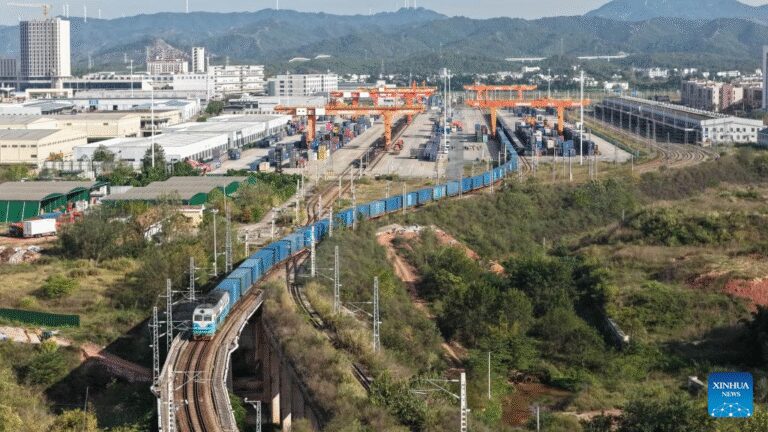
A freight train loaded with goods departs from the Ganzhou International Inland Port in Ganzhou, east China’s Jiangxi Province, Nov. 19, 2025. (Photo by Zhang Mengfei/Xinhua)
NANCHANG, Nov. 25 (Xinhua) — Five years ago, Zhu Hao, marketing general manager of Jiangxi Sanyou Furniture in east China’s Jiangxi Province, could hardly imagine that the European market would one day become a major client. Today, however, Europe accounts for 70 percent of the company’s foreign orders.
The transformation began with a visit from a Hungarian delegation facilitated by the Ganzhou International Inland Port. An order worth 100,000 yuan (14,119.1 U.S. dollars) was placed and shipped via China-Europe freight trains.
“The furniture reached Hungary in just 20 days, less than half the time required by sea transport,” Zhu said. Since then, the company has established stable partnerships with clients in Hungary, Germany and Poland. Last year, its European orders, all shipped via the China-Europe freight train service, exceeded 7 million yuan.
“For us, the China-Europe freight train is not just a rail link across Asia and Europe; it is where our growth and opportunities lie,” Zhu added.
Jiangxi Sanyou Furniture is located in Nankang District of Ganzhou City, known as “China’s solid wood furniture capital.” The district hosts over 10,000 furniture manufacturers and supporting enterprises, employing 500,000 people.
Previously, long sea-shipping cycles of 45 to 60 days made serving the European market challenging. The launch of the China-Europe freight trains gradually changed the situation.
Since the first China-Europe freight train from Jiangxi departed in late 2015, Ganzhou International Inland Port, the only inland open port in Jiangxi and an old revolutionary base area, has operated over 1,700 such trains, building a logistics network spanning Asia and Europe.
Thanks to the service, timber is imported from over 50 countries and regions, while furniture products are exported to more than 100 countries and regions worldwide.
“Using the railway, European timber now arrives in just 12 days, with logistics costs cut by nearly 20 percent,” said Ye Zhangnan, manager of the Ganzhou International Inland Port’s business office under the Nanchang railway logistics center.
“This not only boosts the competitiveness of local furniture companies but also enables businesses across neighboring regions to share resources and collaborate,” Ye said.
The railway has also made imported goods more accessible to Chinese consumers. At a bonded import store at Ganzhou Railway Station, products from Europe are readily available.
“I was drawn to the store while waiting for my train,” said a customer surnamed Huang, holding a pack of British toffees. “The packaging is lovely, perfect for my kids.”
Dai Na, the store manager, said that their goods, which range from cosmetics and personal care items to snacks and beverages, are primarily imported via the China-Europe freight trains.
At the imported commodities center of the Ganzhou International Inland Port, local resident Lu Yi shared, “I live nearby and shop here often. The products are genuine and reasonably priced.”
Ji Weiting, general manager of the supply chain company operating the center, said they offer nearly 7,000 products from over 70 countries and regions, many of which arrive via the China-Europe freight trains.
According to a report on China-Europe freight trains, as of October 2025, the service had made 118,600 trips, transporting 11.7 million twenty-foot equivalent units (TEUs) of goods, reaching 232 cities in 26 European countries. By the end of 2024, the total value of goods transported had reached 426.4 billion U.S. dollars.
“We have established direct links with six border ports and are interconnected with five world-class port clusters,” said Liu Liping, deputy director of the Ganzhou International Inland Port’s operation and management bureau.
“Trade channels are smoother, the level of trade facilitation has significantly improved, and our global network keeps expanding,” said Liu. ■

A customer walks out of a bonded import store at Ganzhou West Railway Station in Ganzhou, east China’s Jiangxi Province, Nov. 12, 2025. (Photo by Zou Yang/Xinhua)

This photo taken on Nov. 19, 2025 shows containers at the Ganzhou International Inland Port in Ganzhou, east China’s Jiangxi Province. (Photo by Zou Yang/Xinhua)

